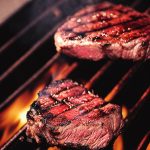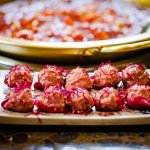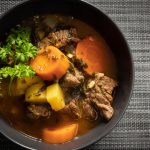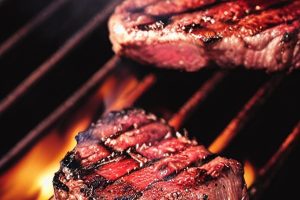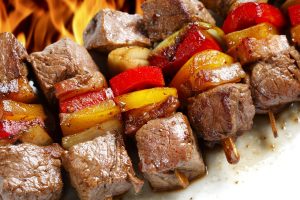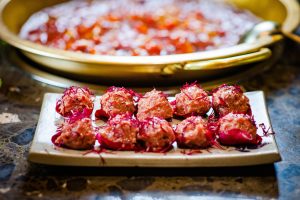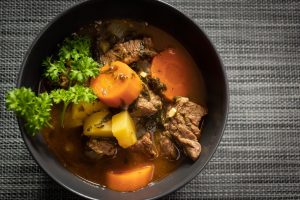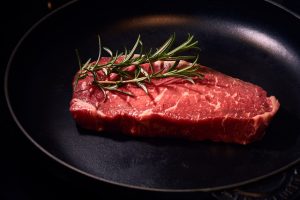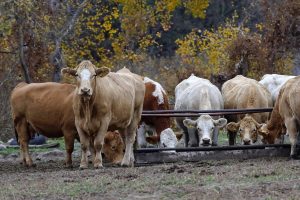Unveiling the Ancient Roots of Moo Shu Beef: Tracing the Origins of a Classic Dish
Moo Shu Beef is a beloved dish that has become a staple in Chinese cuisine. With its flavorful combination of tender beef, crisp vegetables, and savory sauce, it has captured the hearts and palates of food enthusiasts around the world. But have you ever wondered about the ancient roots of this classic dish? In this article, we will delve into the origins of Moo Shu Beef, tracing its history back to its earliest beginnings.
The origins of Moo Shu Beef can be traced back to Northern China, specifically the Shandong province. This region has a rich culinary tradition, known for its hearty and flavorful dishes. Moo Shu Beef is believed to have originated in the late Ming Dynasty, which spanned from the 14th to the 17th century.
During this time, the dish was initially known as “Mu Xu Rou.” In Chinese, “Mu Xu” translates to “wood shavings,” which refers to the thin strips of wood-like mushrooms that were traditionally used in the dish. “Rou” means “meat,” which highlights the key ingredient of beef in the original recipe.
The popularity of Moo Shu Beef quickly spread beyond the Shandong province and reached the capital, Beijing. It became a favorite among the imperial court and was served during grand banquets and celebrations. Its flavorful combination of ingredients and visually appealing presentation made it a standout dish, appreciated by both the nobility and commoners alike.
Over time, the recipe for Moo Shu Beef evolved, incorporating new ingredients and techniques. The thin strips of mushrooms were eventually replaced with wood ear fungus, which added a unique texture and flavor to the dish. The use of cabbage, carrots, and other vegetables also became common, further enhancing the dish’s taste and nutritional value.
Moo Shu Beef eventually made its way to the United States in the mid-20th century, with the influx of Chinese immigrants. It gained popularity in Chinese-American restaurants, where it was adapted to suit the American palate. The addition of hoisin sauce and the use of flour tortillas instead of traditional Chinese pancakes became distinguishing characteristics of the Americanized version of the dish.
Today, Moo Shu Beef continues to be enjoyed by people all over the world. Its ancient roots and rich history add to its allure, making it not just a delicious meal, but also a cultural icon. Whether you savor it in a traditional Chinese restaurant or enjoy a modern twist on the dish, Moo Shu Beef is a testament to the enduring legacy of Chinese cuisine.
In conclusion, the roots of Moo Shu Beef can be traced back to the Shandong province in Northern China during the late Ming Dynasty. Its journey from a regional delicacy to a worldwide favorite showcases the evolution and adaptability of Chinese cuisine. So, the next time you indulge in a plate of Moo Shu Beef, take a moment to appreciate the ancient traditions and flavors that have come together to create this beloved classic.
From Ancient China to Modern Kitchens: The Evolution of Moo Shu Beef
Moo Shu Beef is a popular Chinese dish that has a long and fascinating history, dating back to ancient China. Over the centuries, it has evolved and transformed, adapting to different regions and culinary preferences. Today, it has become a staple in modern kitchens, loved by people all around the world. In this article, we will explore the evolution of Moo Shu Beef, from its origins in ancient China to its present form.
The origins of Moo Shu Beef can be traced back to the Northern Song Dynasty (960-1127 AD) in China. During this time, the dish was known as “Moo Shu Pork,” made with stir-fried pork and various vegetables. It was a favorite among the imperial court and was often served during banquets and special occasions.
During the Ming Dynasty (1368-1644 AD), the dish underwent a significant transformation. It was during this time that beef was introduced as an alternative to pork. The addition of beef gave the dish a richer and more savory flavor, making it even more popular among the Chinese population. The use of various vegetables, such as cabbage, mushrooms, and bamboo shoots, also became common during this period.
As Chinese cuisine spread to different regions of the country, variations of Moo Shu Beef started to emerge. In the Sichuan province, for example, the dish became spicier, with the addition of Sichuan peppercorns and chili peppers. In the Guangdong province, on the other hand, the dish took on a sweeter flavor, with the inclusion of ingredients like oyster sauce and sugar.
The popularity of Moo Shu Beef continued to grow during the Qing Dynasty (1644-1912 AD), when it became a staple in the everyday diet of the Chinese people. It was during this time that the dish started to be served with Mandarin pancakes, which are thin, round pancakes made from wheat flour. These pancakes added a delightful texture and served as a perfect vessel for wrapping the flavorful beef and vegetable mixture.
In the late 19th century, Chinese immigrants brought their culinary traditions to the United States, including Moo Shu Beef. As Chinese cuisine gained popularity in America, Moo Shu Beef became a beloved dish in Chinese-American restaurants. However, some adjustments were made to suit the American palate. For example, hoisin sauce, a sweet and savory sauce made from fermented soybeans, was added to enhance the flavor.
In modern kitchens, Moo Shu Beef continues to be a favorite among Chinese food enthusiasts. The dish has become more accessible, with pre-made Moo Shu sauce and pancakes readily available in grocery stores. Home cooks have also started experimenting with different ingredients and flavors, adding their own personal twist to the traditional recipe.
In conclusion, Moo Shu Beef has come a long way from its origins in ancient China. It has adapted and evolved over the centuries, incorporating new ingredients and flavors to suit different regions and tastes. Today, it remains a beloved dish, enjoyed by people all over the world. Whether you prefer the traditional recipe or a modern twist, Moo Shu Beef is a true testament to the rich culinary heritage of China.
A Taste of History: Exploring the Cultural Significance of Moo Shu Beef
Moo Shu Beef is a classic Chinese dish that has a long and rich history, deeply rooted in the cultural traditions of China. This dish is not only a culinary delight but also holds significant cultural importance. In this article, we will explore the origins of Moo Shu Beef and discuss its cultural significance.
Moo Shu Beef, also known as “Moo Shu Rou” in Mandarin, is believed to have originated in Northern China during the Ming Dynasty (1368-1644). It was traditionally prepared using pork, but beef became a popular substitute in later years. The dish is a stir-fry made with thinly sliced beef, scrambled eggs, wood ear mushrooms, and a variety of vegetables such as cabbage, carrots, and bamboo shoots. It is seasoned with a combination of soy sauce, hoisin sauce, and other Chinese spices.
The cultural significance of Moo Shu Beef lies in its association with ancient Chinese culinary traditions and the values it represents. In Chinese culture, food is not just a means of sustenance but also a way to connect with one’s heritage and demonstrate respect for one’s ancestors. Moo Shu Beef, with its long history and traditional preparation methods, embodies these values.
Furthermore, Moo Shu Beef is often served at celebratory occasions such as weddings, family gatherings, and festivals. It symbolizes good fortune, abundance, and unity among family members. In Chinese culture, sharing a meal is considered a way to strengthen social bonds and foster harmony within the community. By serving Moo Shu Beef, hosts demonstrate their hospitality and generosity, creating a sense of togetherness among guests.
The preparation and presentation of Moo Shu Beef also hold cultural significance. The dish is traditionally served with Mandarin pancakes, which are thin and delicate. These pancakes symbolize unity and balance, as they are folded and filled with a harmonious mixture of meat and vegetables. Eating Moo Shu Beef with pancakes is not only a sensory experience but also a symbolic representation of the balance and harmony that Chinese culture strives to achieve.
In conclusion, Moo Shu Beef is more than just a delicious dish; it is a cultural treasure that reflects the traditions and values of Chinese society. Its origins in the Ming Dynasty, its association with celebratory occasions, and its symbolic representation of unity and balance make it an integral part of Chinese culinary heritage. So, the next time you enjoy a plate of Moo Shu Beef, remember the cultural significance behind this culinary masterpiece.
Mingling Flavors: The Influences and Ingredients that Shape Moo Shu Beef
Mingling Flavors: The Influences and Ingredients that Shape Moo Shu Beef
Introduction:
Moo Shu Beef is a classic Chinese dish that has gained popularity around the world for its rich flavors and unique combination of ingredients. This article explores the influences and ingredients that shape this delectable dish, providing a deeper understanding of its origins and cultural significance.
Influences on Moo Shu Beef:
Moo Shu Beef is heavily influenced by the culinary traditions of northern China, particularly the Shandong and Beijing regions. These areas are known for their emphasis on hearty and flavorful dishes, incorporating a wide variety of ingredients to create a harmonious balance of taste and texture. Moo Shu Beef embodies this tradition by combining tender beef with a medley of vegetables and aromatic seasonings.
Ingredients in Moo Shu Beef:
- Beef: The star of the dish, beef is typically sliced thinly and marinated in a mixture of soy sauce, rice wine, and cornstarch. This marinade not only adds flavor but also helps to tenderize the meat, ensuring a succulent texture when cooked.
- Vegetables: Moo Shu Beef commonly includes a colorful array of vegetables such as cabbage, carrots, mushrooms, and bamboo shoots. These vegetables not only enhance the visual appeal of the dish but also provide a delightful crunch and freshness.
- Pancakes: Moo Shu Beef is traditionally served with thin, delicate pancakes made from flour. These pancakes act as a vessel for the beef and vegetable filling, adding a soft and slightly chewy texture to each bite. The pancakes are often brushed with hoisin sauce, a sweet and savory condiment that complements the flavors of the dish.
- Seasonings: Moo Shu Beef is seasoned with a combination of soy sauce, ginger, garlic, and hoisin sauce. These seasonings infuse the dish with a robust and savory flavor profile, elevating the taste of the beef and vegetables.
Cultural Significance:
Moo Shu Beef holds a special place in Chinese cuisine, representing the art of balance and harmony in flavors and textures. Its origins can be traced back to the imperial kitchens of ancient China, where it was created as a dish fit for royalty. Over time, it became a staple in Chinese households and eventually spread to other parts of the world, captivating the taste buds of people from diverse cultures.
Conclusion:
Moo Shu Beef is a testament to the rich culinary heritage of northern China. Its combination of tender beef, vibrant vegetables, and aromatic seasonings creates a symphony of flavors that delight the palate. By understanding the influences and ingredients that shape this dish, we gain a deeper appreciation for its cultural significance and the craftsmanship behind its creation. Whether enjoyed in a traditional Chinese restaurant or prepared at home, Moo Shu Beef is sure to satisfy and leave a lasting impression.
Beyond the Plate: Uncovering the Stories and Traditions behind Moo Shu Beef
Moo Shu Beef is a popular dish in Chinese cuisine that has gained popularity around the world. It is known for its delicious combination of tender beef, crunchy vegetables, and savory sauce, all wrapped in a delicate pancake. However, there is much more to this dish than meets the eye. In this article, we will delve into the stories and traditions behind Moo Shu Beef, uncovering its rich history and cultural significance.
The origins of Moo Shu Beef can be traced back to northern China, specifically the Shandong province. It was originally a dish made with pork, known as Moo Shu Pork. However, when this dish made its way to the United States in the early 20th century, beef was substituted for pork to cater to the tastes of the American audience. Despite this change, the essence of the dish remained the same.
One of the key elements of Moo Shu Beef is the use of Mandarin pancakes. These thin, round pancakes are made from a mixture of flour and water, which is then rolled out and cooked on a griddle. The pancakes are an essential part of the dish, as they serve as the vessel for the beef and vegetable filling. Their delicate texture and subtle flavor enhance the overall experience of eating Moo Shu Beef.
Traditionally, Moo Shu Beef is served with a variety of condiments, allowing diners to customize their own flavors. These condiments typically include hoisin sauce, soy sauce, and scallions. Hoisin sauce, in particular, is a thick, sweet sauce made from soybeans, garlic, sugar, and various spices. Its rich and tangy taste complements the savory beef and adds a depth of flavor to the dish.
In Chinese culture, Moo Shu Beef is often associated with celebrations and special occasions. It is commonly served at weddings, family gatherings, and New Year’s celebrations. The dish is seen as a symbol of abundance and prosperity, as the combination of beef and vegetables represents a bountiful harvest. It is also believed to bring good luck and fortune to those who consume it.
In conclusion, Moo Shu Beef is more than just a delicious Chinese dish. It is a culinary masterpiece that carries with it a rich history and cultural significance. From its origins in northern China to its adaptation in the United States, this dish has evolved over time while maintaining its essence. The use of Mandarin pancakes and a variety of condiments elevate the flavors and textures of the dish, making it a delight to eat. Whether enjoyed at a special occasion or as a simple weeknight meal, Moo Shu Beef is a true testament to the art of Chinese cuisine.
